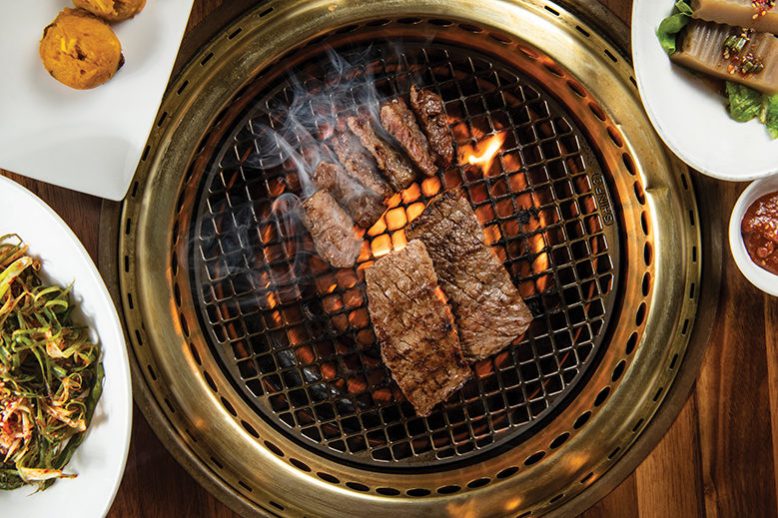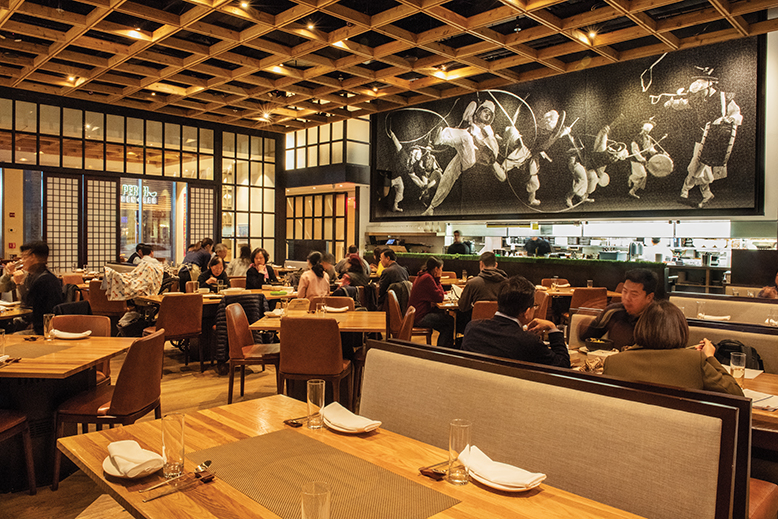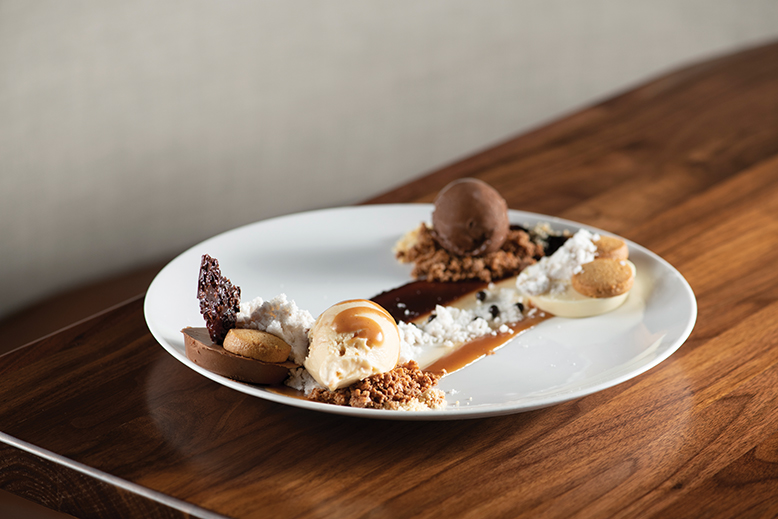



Fort Lee and neighboring Palisades Park are home to scads of no-frills Korean barbecue and noodle joints. Andy Sung, owner of the high-end Korean restaurant Gaonnuri in Manhattan, knows those places well from decades of visiting relatives in Bergen County.
“I’ve always found it embarrassing,” he says, “that there was not a single place in the area where I could take friends for Korean food that wasn’t rushed, uncomfortable and smoky.” Sung, who lives in Manhattan, studied architecture in Seoul before building a successful contracting business in Long Island.
“My dream after retiring,” says the 61-year-old, “was to create beautiful, welcoming spaces for Koreans who want somewhere nicer to eat and for non-Koreans who want to discover our gorgeous cuisine.”
That dream came to fruition in June 2017 with the opening of Gayeon in the Hudson Lights complex in Fort Lee. Gayeon means “beautiful encounter,” and the high-ceilinged 6,600-square-foot space delivers on that promise. Combining his architectural know-how with a deep interest in contemporary Korean art and design, Sung has created a one-of-a-kind showcase. It features a commissioned, billboard-size mural, Maya Harvest Dance by Seungmo Park, made of wire mesh, depicting figures swirling in motion like spacewalking astronauts. On the broad wall of the rear dining room, a commissioned projection by Minha Yanf, The Weight of the Words, creates the illusion of snowflakes piling up and then sinking to the floor. On closer inspection, the snowflakes are Korean words. They describe a UNESCO World Heritage site in South Korea.

The commissioned mural of spinning dancers overlooks the main dining room. Photo by Cayla Zahoran
For all its grandeur, Gayeon pulls off an intimate elegance, with traditional Korean room dividers and graciously spaced seating that make conversation easy. Astonishingly, even with gas-fired braziers built into most tables, there isn’t a wisp of smoke in the air. The grills stealthily suck fumes into a downdraft.
In the kitchen, Korean-born Tae Goo Kang, who trained at the French Culinary Institute and was Gaonnuri’s original chef, deftly executes a menu similar to Gaonnuri’s. Stir-fried baby octopus (nakji bokkeum) was at once tender and chewy, a cloak of gochujang red-pepper paste giving it a sweet, slow burn. A duo of sizzling-crisp scallion pancakes were packed with tasty bits of squid, shrimp and mussels.
Next time I have a cold, I may drive to Fort Lee in my pj’s for Gayeon’s full-bodied ginseng chicken soup, which bobbed with shreds of juicy chicken thigh and tangles of firm noodles. The dolsot bibimbap—a hot-stone bowl packed with stir-fried rice, veggies and a protein (we had marinated short rib one night, seafood another)—were bliss. We seasoned the mix to taste with gochujang and fought over every crisped rice shard.

Nakji bokkeum (spicy red pepper octopus, with sprouts). Photo by Cayla Zahoran
We were surprised to see a calamari salad topping the list of appetizers. “It isn’t traditional,” admits Sung, “but I added it because I like it.” One of the few fusion dishes, its rings of battered, gochujang-bathed squid were served with a mesclun salad. A tasty bridge for newbies, it’s dispensable for more seasoned and adventurous eaters. (Offering appetizers, Sung notes, is a concession to Western meal pacing. Korean dishes traditionally arrive together in one fell swoop.)
On my first of three visits, I was accompanied by two Korean-American friends. They agreed with the rest of the table that Gayeon’s japchae was spot-on, the springy glass noodles and tender-crisp veggies glazed salty and sweet, with a smoky kiss from bits of flame-seared beef. Kimchi jjigae, a gutsy red broth rich with pork belly, tofu and aged, fermented cabbage, also brought nods of approval.
All this was mere preamble to the main event: Korean barbecue. Minutes after our grill was lit, we were swamped by a wave of banchan (kimchi and other treats that come with virtually every Korean meal) and traditional barbecue sides (potato salad, kimchi, squares of acorn jelly and several more). Though the options included American-style steaks, duck and lamb, we went with two classics: bulgogi (paper-thin slices of beef rib-eye) and galbi (marinated short ribs), which our server deftly seared on both sides.
The meats lacked the smoky char imparted by charcoal—the ne plus ultra of Korean barbecue. But the frizzled bits of bulgogi and juicy, fattier morsels of short rib, folded into crisp red lettuce leaves with chili-bathed scallion ribbons and julienned pickled radish, were, for the most part, delicious and satisfying. I qualify that because, on one visit, some pieces of galbi were grossly fatty and fibrous.
Barbecue isn’t the only option for a main course. Soy-braised black cod jorim arrived fragrant and bubbling in a petite, black stew pot. Willing to explore, we tried bibim naengmyun, buckwheat noodles in cold beef broth traditionally taken as a post-barbecue palate cleanser. Served in an entrée-sized bowl flecked with bits of ice, it was bracing and tasty, but a few spoonfuls was plenty. Too bad our server hadn’t told us it was available as a side dish instead of trying to steer us away entirely, since “Americans never seem to finish it.”
Sung says he has focused much energy on service, which at less aspirational Korean restaurants can be rushed, remote and utterly befuddling for non-Koreans. On my first visit, our polished server, Jason, patiently walked us through Gayeon’s potentially overwhelming menu and helped us choose from the list of cocktails made with Korean spirits.
On two subsequent visits, however, our servers provided little guidance except for some misinformation (telling us pickled radish was octopus in our delectable bossam appetizer; the octopus was wrapped in kimchi beside the pickled radish). They left us to languish at our table strewn with dirty dishes before finally wandering over with dessert menus. On both occasions, floor staff stared blankly through us from the periphery, occasionally muttering into their efficient-looking (but obviously underused) headsets.

The deconstructed Snickers bar. Photo by Cayla Zahoran
“We are aware of negative reviews about our service, and we are working though that issue,” responds Sung. His son, Brian, who sometimes helps with the business, says that more effort will be put into staff training.
Koreans generally don’t do dessert. Lily Soojin An, Gayeon’s Cordon Bleu-trained pastry chef, gives good reason to break that pattern. From her luxe chocolate lava cake to her deconstructed Snickers bar with freeze-dried peanut butter powder to her bowlful of warm lemon madeleines, there’s not a dud in the bunch.
Restaurant Details
- Cuisine Type:Korean
- Price Range:Expensive
- Price Details:Appetizers, $12-$15; sides, $5-$14; barbecue, $27-$56; entrées, $16-$39; desserts, $6-$13
- Ambience:Artful, open, comfortable
- Service:Mostly polished and helpful
- Wine list:Full bar, signature cocktails made with Korean spirits
